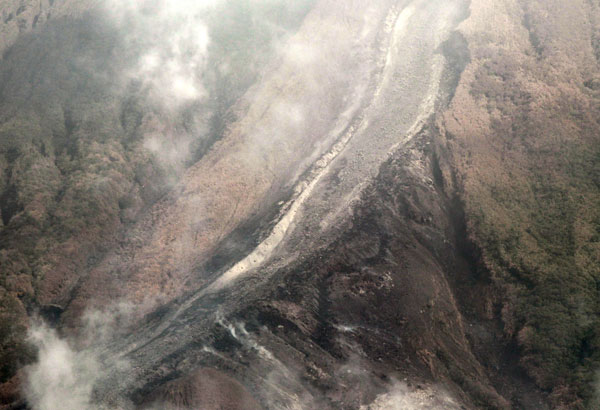Lahar alert up in Albay due to LPA

Lahar flows in a gully near Mayon Volcano in Daraga, Albay yesterday. Krizjohn Rosales
LEGAZPI CITY , Philippines — Local and disaster officials were alerted yesterday on the possible onslaught of lahar around Mayon Volcano after a low-pressure area was spotted.
The low-pressure area was located 650 kilometers east-southeast of this city.
“Lahar is now a permanent threat to communities around the volcano due to new and old pyroclastic deposits,” Renato Solidum, Philippine Institute of Volcanology and Seismology director, said.
Solidum said around 53.5 million cubic meters of pyroclastic materials have been extruded by the volcano since Jan. 13.
“We also have to monitor the volcano’s eruptions due to a large supply of new magma that is moving toward the crater,” he said.
He said lava extrusion has reached 4.5 kilometers and 3.2 kilometers in the Bonga and Miisi gullies, respectively.
Solidum said they are also checking if there are lava flows in the Basud channel.
Sporadic to near-continuous lava fountaining, lava flows and degassing from the crater that generated steam-laden ash plumes that reached up to four hundred meters were observed in the past 24 hours.
On Monday night, lava flows and rockfalls were observed in the Miisi and Bonga-Buyuan channels.
A total 116 volcanic earthquakes, most of which corresponded to lava fountaining and accompanied by rumbling sounds, were recorded by Mayon’s seismic monitoring network.
High-quality relief goods
Meanwhile, the Commission on Human Rights (CHR) lauded the Department of Social Welfare and Development (DSWD) for ensuring the high quality of relief goods distributed to Mayon evacuees.
The CHR said the Guiding Principles on Internal Displacement mandates that humanitarian assistance shall be carried out in accordance with international human rights laws, including the distribution of relief goods that are safe to eat.
DSWD officer-in-charge Emmanuel Leyco assured Mayon evacuees that food items distributed to them are not expired.
Leyco said they would immediately act on complaints on disaster response protocols.
He said relief operations would continue as long as there are families staying in evacuation centers and until evacuees return to their homes as part of the recovery phase.
“We have a plan in place…to support evacuees for 100 days and afterwards,” Leyco said. – With Janvic Mateo, Cet Dematera
- Latest
- Trending































